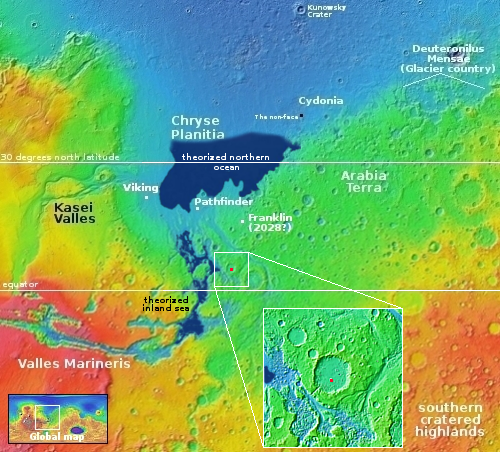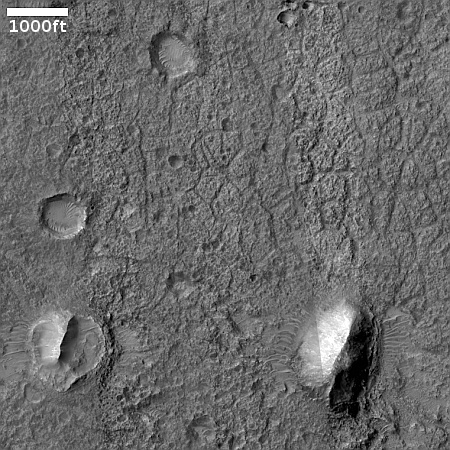The drying out of Mars’ tropics
Cool image time! The picture to the right, cropped, reduced, and sharpened to post here, was taken on June 26, 2023 by the high resolution camera on Mars Reconnaissance Orbiter (MRO). The science team calls the features surrounding these small 20 to 60 foot high hills “polygon features,” an apt description and a geological feature that is seen in many places on Mars.
When these features are found in the icy higher latitudes, it is believed they are formed in connection to the freeze-thaw cycle that causes cracks in the near surface ice. When found in the dry equatorial regions, where these polygons are located, they are usually thought to be ancient evidence of past standing water that left behind these cracks, much like the cracks seen in mud after the water has evaporated away on Earth.
The formation of these tiny hills is a bit more complex.

The red dot on the overmap to the right marks the location of these polygons, inside 85-mile wide Galilaei Crater. Scientists believe catastrophic floods coming down from Valles Marineris filled the crater with a lake, as well as leaving behind the nearby inland sea noted in blue on the map. Later that lake drained out through a breach in the crater’s southwestern wall, leaving behind its cracked floor with many of these strange little hills in its southern half.
These cracks have been here for a long while, but it is also possible that during the wide swings in Mars’ rotational tilt, from 11 to 60 degrees the Martian tropics might have seen many cycles of wetter weather, even after those catastrophic floods were long gone. The polygons here might thus not be from those floods, but from later cycles.
And of course, there is always the question of whether these features were caused by liquid water or ice, since the existence of running liquid water on the surface of Mars at any time in the past remains unproven. Based on the known data the climate has apparently always been too cold and the atmosphere too thin.
On Christmas Eve 1968 three Americans became the first humans to visit another world. What they did to celebrate was unexpected and profound, and will be remembered throughout all human history. Genesis: the Story of Apollo 8, Robert Zimmerman's classic history of humanity's first journey to another world, tells that story, and it is now available as both an ebook and an audiobook, both with a foreword by Valerie Anders and a new introduction by Robert Zimmerman.
The print edition can be purchased at Amazon or from any other book seller. If you want an autographed copy the price is $60 for the hardback and $45 for the paperback, plus $8 shipping for each. Go here for purchasing details. The ebook is available everywhere for $5.99 (before discount) at amazon, or direct from my ebook publisher, ebookit. If you buy it from ebookit you don't support the big tech companies and the author gets a bigger cut much sooner.
The audiobook is also available at all these vendors, and is also free with a 30-day trial membership to Audible.
"Not simply about one mission, [Genesis] is also the history of America's quest for the moon... Zimmerman has done a masterful job of tying disparate events together into a solid account of one of America's greatest human triumphs."--San Antonio Express-News
Cool image time! The picture to the right, cropped, reduced, and sharpened to post here, was taken on June 26, 2023 by the high resolution camera on Mars Reconnaissance Orbiter (MRO). The science team calls the features surrounding these small 20 to 60 foot high hills “polygon features,” an apt description and a geological feature that is seen in many places on Mars.
When these features are found in the icy higher latitudes, it is believed they are formed in connection to the freeze-thaw cycle that causes cracks in the near surface ice. When found in the dry equatorial regions, where these polygons are located, they are usually thought to be ancient evidence of past standing water that left behind these cracks, much like the cracks seen in mud after the water has evaporated away on Earth.
The formation of these tiny hills is a bit more complex.

The red dot on the overmap to the right marks the location of these polygons, inside 85-mile wide Galilaei Crater. Scientists believe catastrophic floods coming down from Valles Marineris filled the crater with a lake, as well as leaving behind the nearby inland sea noted in blue on the map. Later that lake drained out through a breach in the crater’s southwestern wall, leaving behind its cracked floor with many of these strange little hills in its southern half.
These cracks have been here for a long while, but it is also possible that during the wide swings in Mars’ rotational tilt, from 11 to 60 degrees the Martian tropics might have seen many cycles of wetter weather, even after those catastrophic floods were long gone. The polygons here might thus not be from those floods, but from later cycles.
And of course, there is always the question of whether these features were caused by liquid water or ice, since the existence of running liquid water on the surface of Mars at any time in the past remains unproven. Based on the known data the climate has apparently always been too cold and the atmosphere too thin.
On Christmas Eve 1968 three Americans became the first humans to visit another world. What they did to celebrate was unexpected and profound, and will be remembered throughout all human history. Genesis: the Story of Apollo 8, Robert Zimmerman's classic history of humanity's first journey to another world, tells that story, and it is now available as both an ebook and an audiobook, both with a foreword by Valerie Anders and a new introduction by Robert Zimmerman.
The print edition can be purchased at Amazon or from any other book seller. If you want an autographed copy the price is $60 for the hardback and $45 for the paperback, plus $8 shipping for each. Go here for purchasing details. The ebook is available everywhere for $5.99 (before discount) at amazon, or direct from my ebook publisher, ebookit. If you buy it from ebookit you don't support the big tech companies and the author gets a bigger cut much sooner.
The audiobook is also available at all these vendors, and is also free with a 30-day trial membership to Audible.
"Not simply about one mission, [Genesis] is also the history of America's quest for the moon... Zimmerman has done a masterful job of tying disparate events together into a solid account of one of America's greatest human triumphs."--San Antonio Express-News


